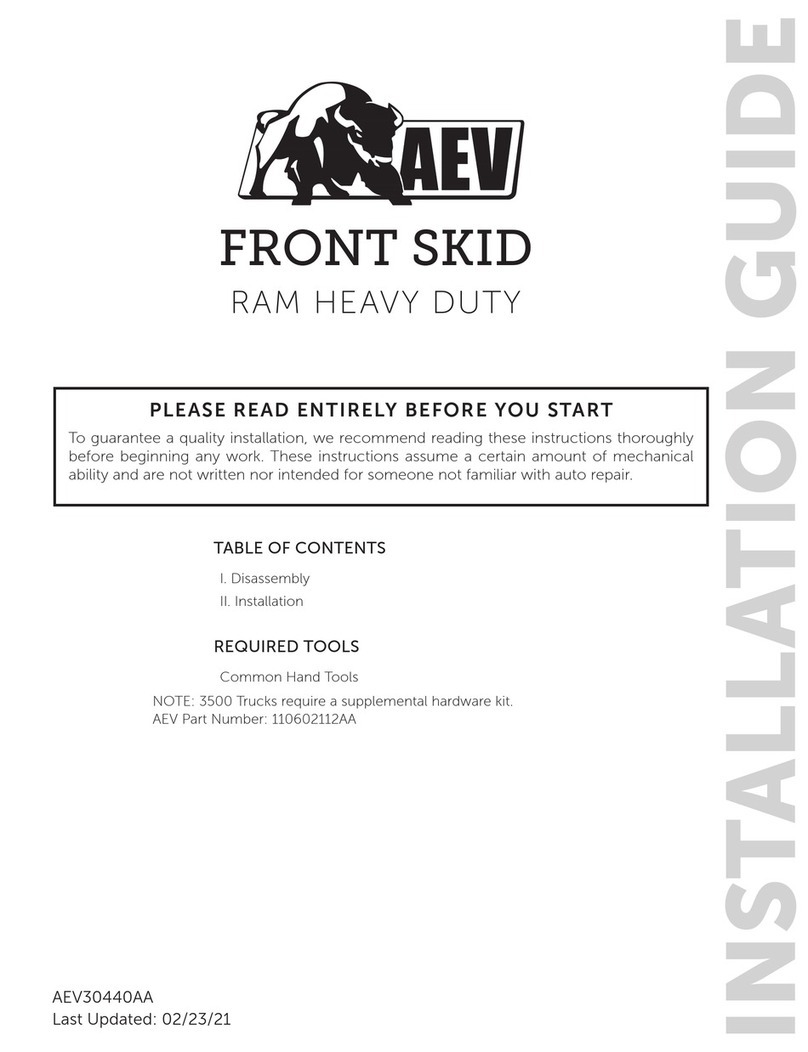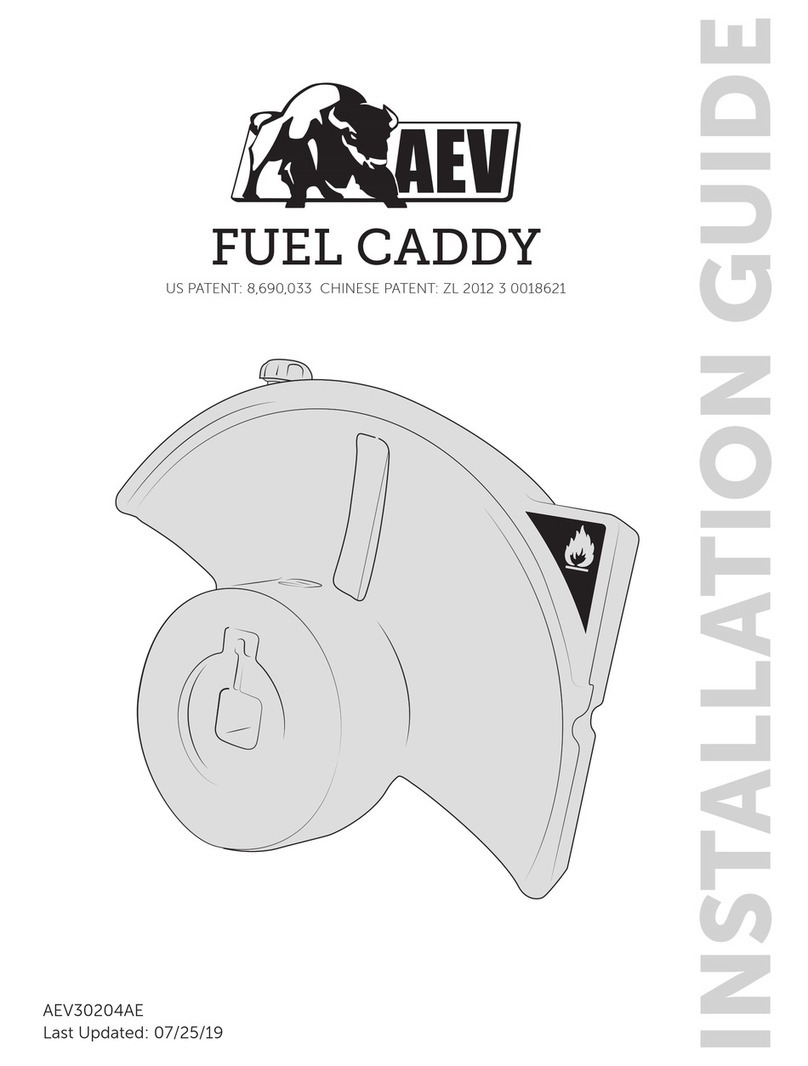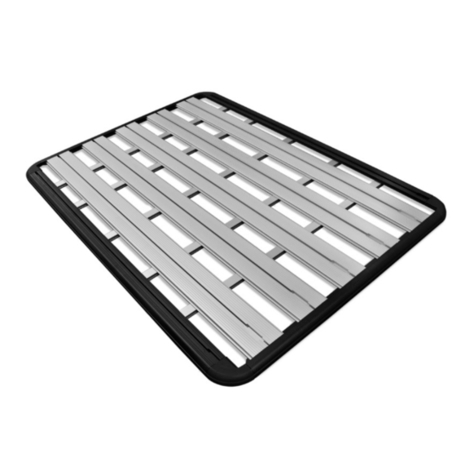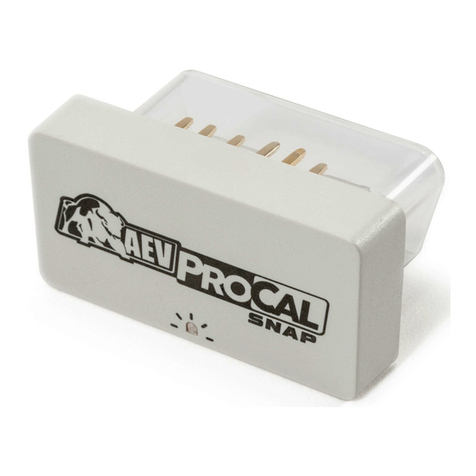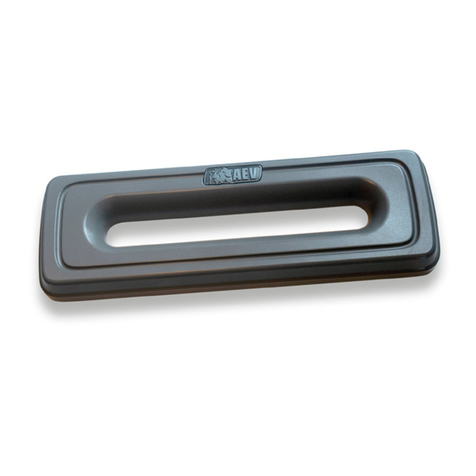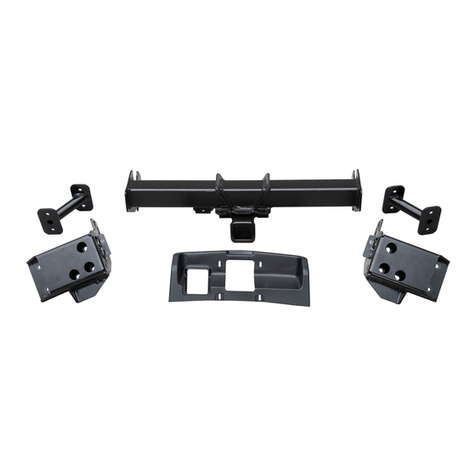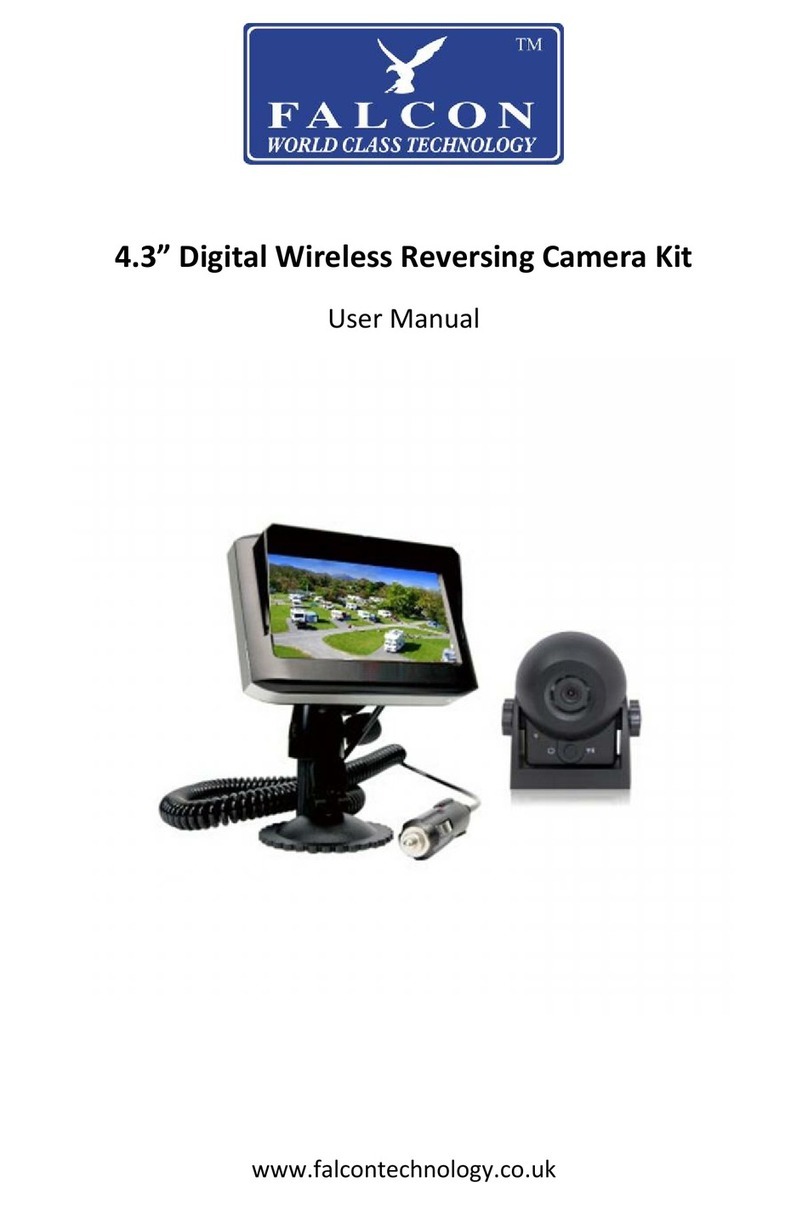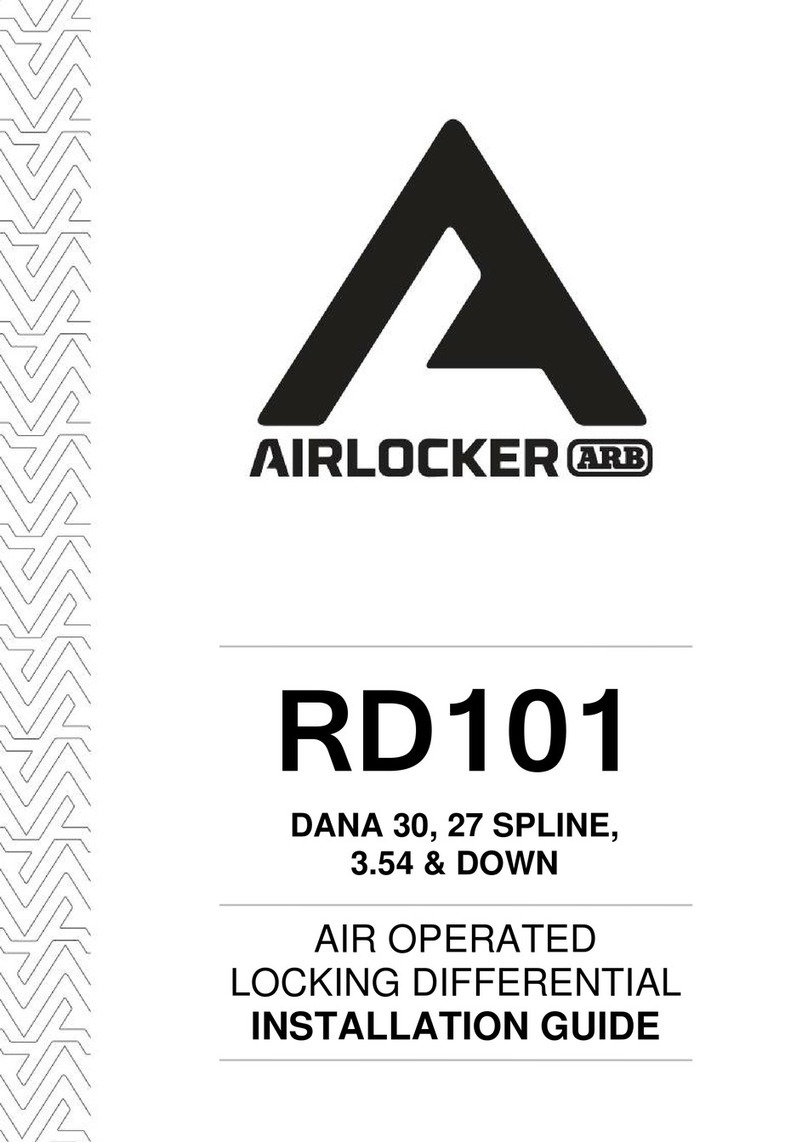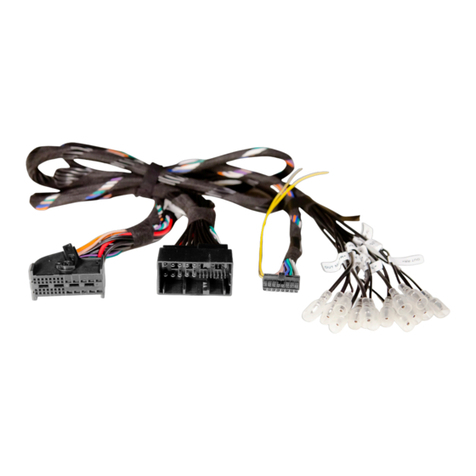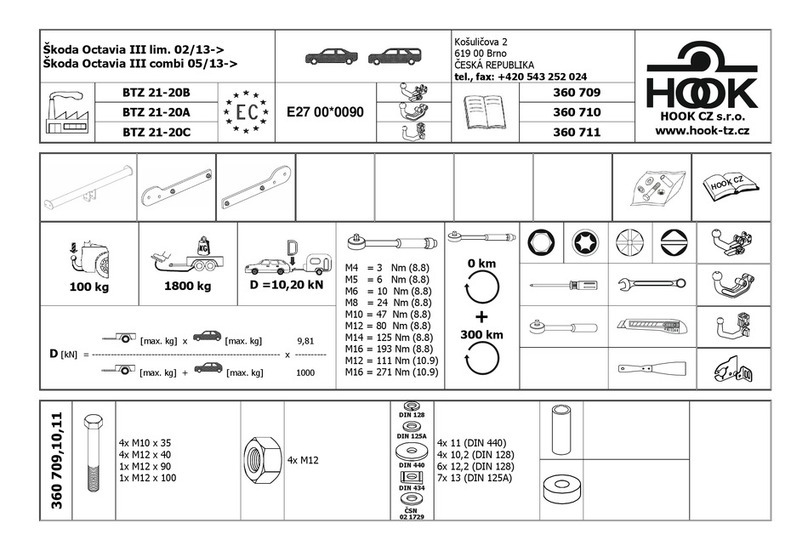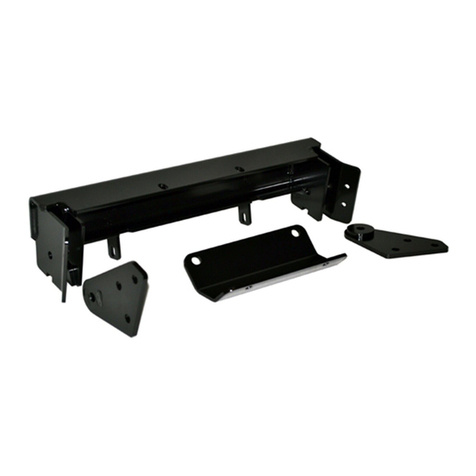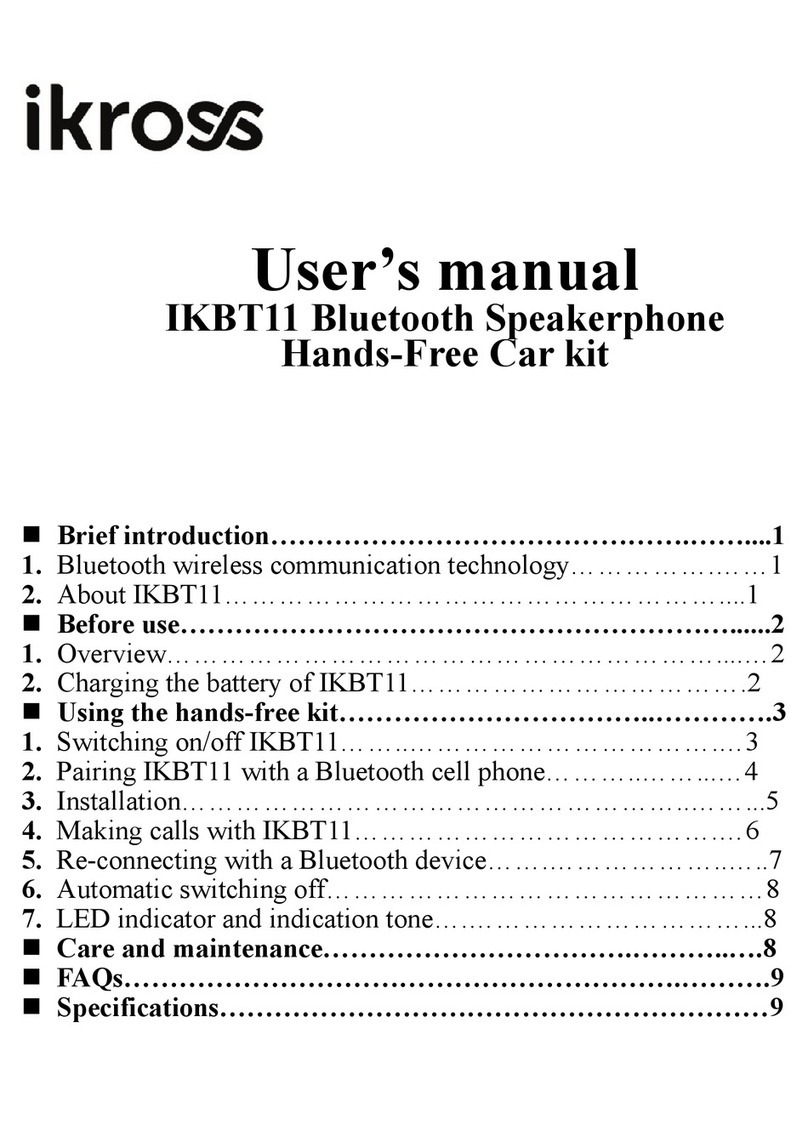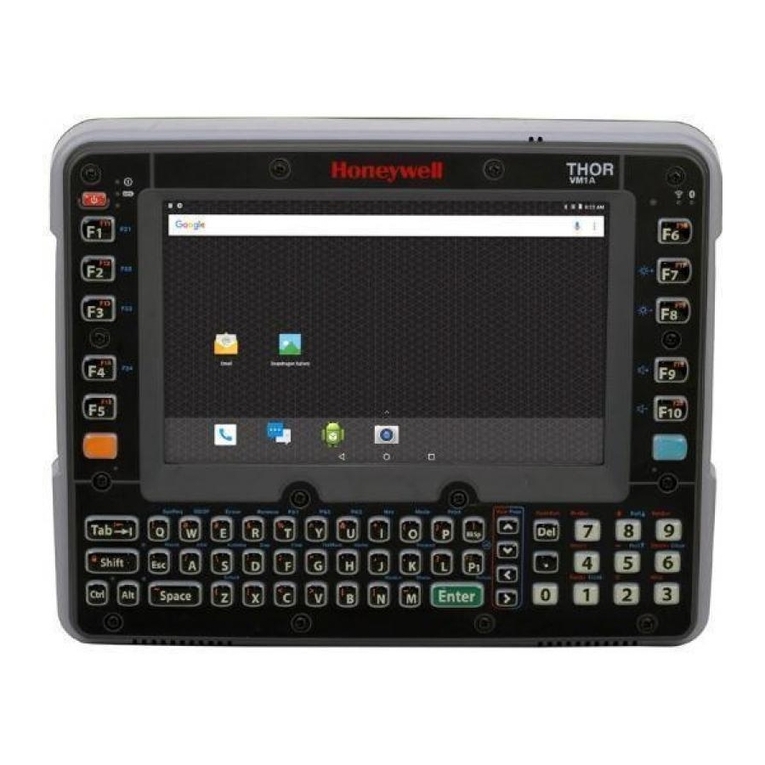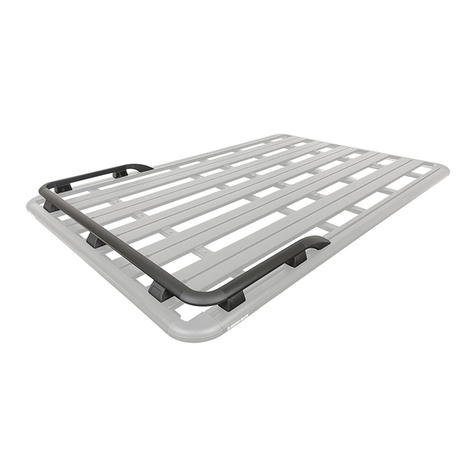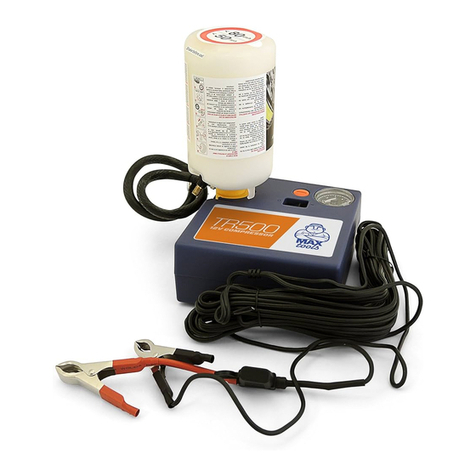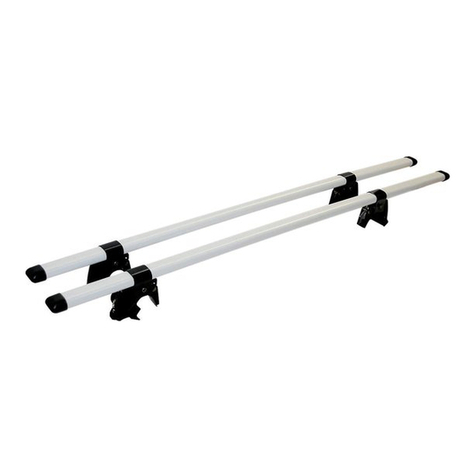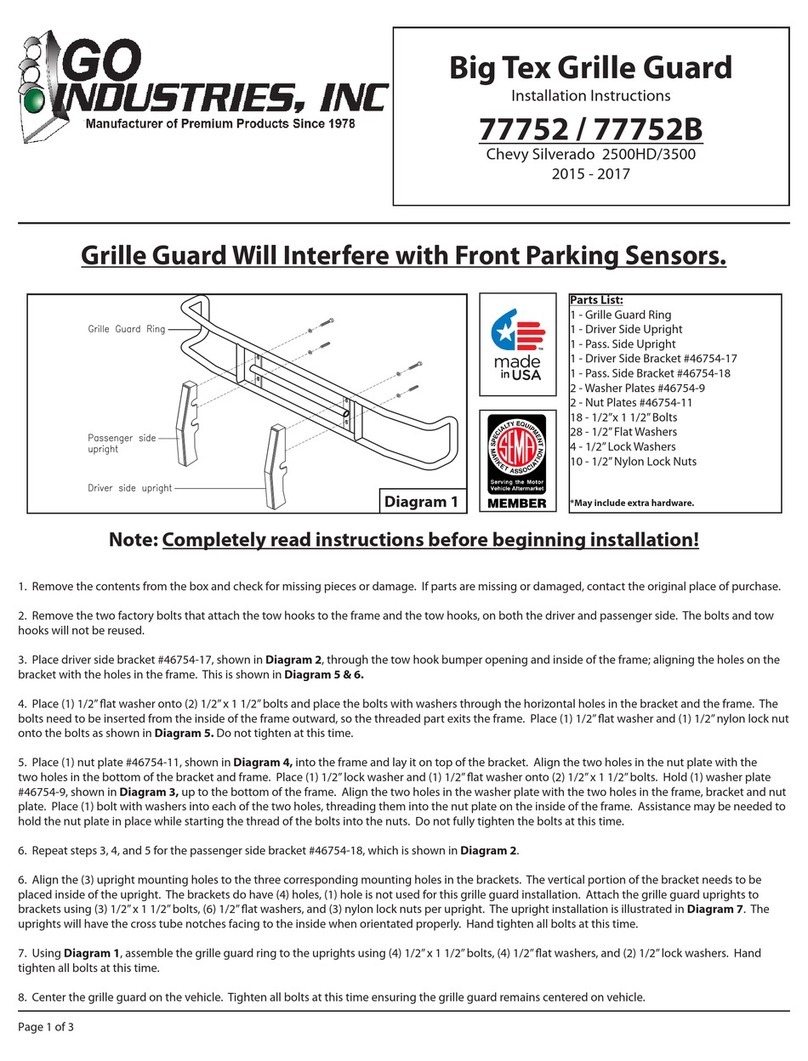AEV PROCAL User manual

PROCAL
MODULE
USER MANUAL
2007+ JK WRANGLER

AEV ProCal Module
User MANUAL
Please consult the Troubleshooting Guide if
you experience any issues.
INCLUDED PARTS QTY REQUIRED TOOLS
ProCal Module 1 Fine pointed instrument
Quick Reference Guide 1 for toggling switches
FEATURES OF THE MODULE
The ProCal Module allows the user to adjust several
factory parameters including:
• Tire Size
• Gear Ratio
• Transfer Case Low Ratio
• One Touch Lane Change
• Daytime Running Lamps
• Low Tire Pressure Indicator
• Smart Bar Indicator Disable (after Smart Bar
removal)
While the module is plugged into the OBD port, the
ProCal Module can also:
• Set a Temporary Extended Idle
• Provide a Dead Center Steering Wheel Indication
• Clear Diagnostic Trouble Codes (DTGs)/Turn of
Check Engine Lamp

AEV ProCal Module
User MANUAL
Please consult the Troubleshooting Guide if
you experience any issues.
INCLUDED PARTS QTY REQUIRED TOOLS
ProCal Module 1 Fine pointed instrument
Quick Reference Guide 1 for toggling switches
FEATURES OF THE MODULE
The ProCal Module allows the user to adjust several
factory parameters including:
• Tire Size
• Gear Ratio
• Transfer Case Low Ratio
• One Touch Lane Change
• Daytime Running Lamps
• Low Tire Pressure Indicator
• Smart Bar Indicator Disable (after Smart Bar
removal)
While the module is plugged into the OBD port, the
ProCal Module can also:
• Set a Temporary Extended Idle
• Provide a Dead Center Steering Wheel Indication
• Clear Diagnostic Trouble Codes (DTGs)/Turn of
Check Engine Lamp

For AEV HEMI Builders Kits, the ProCal Module will:
• Program the Vehicle’s VIN into the new PCM
controller (only required for older kits)
• Program the Pedal Calibration and Tolerance
• Adjust transmission settings for your 5.7L or 6.4L
engine on 2012 or newer vehicles
The ProCal Module is only designed to be plugged into
the vehicle during programming or activation of runtime
features. Between uses AEV recommends storing the unit
in the glove box or console. It is important to cycle the key
OFF after any successful programming before starting/
running the vehicle.
The module will lock to a vehicle’s VIN number and may
not be used on another vehicle until the “RESTORE”
function is used on the original vehicle. The “RESTORE”
function will reset a vehicle’s default settings to stock
and unlock the module for use in another vehicle. It IS
NOT recommended to try and pull a vehicle’s settings out
before selling it. Because some transmissions require
altered settings to use different physical axle ratios, the
ProCal once used must remain with those new gears in
the vehicle. It may seem tempting to keep the ProCal
and use it on your new Jeep, but this often leads to
incompatibility with the new or old vehicle. We highly
recommend selling vehicles and including the ProCal
attached to it.
Programming Procedure: Set the DIP switches
accordingly using this User Guide or the Quick Reference
Card. With the engine off and the ignition on, plug the
module into the ODB port and wait for the horn to sound.
If the horn does not sound, consult the troubleshooting
section of these instructions. It is important to cycle
the key OFF after any successful programming before
starting/running the vehicle.
The ProCal is FAST. It will honk very soon after you plug it
in. This is normal.
Unhooking the battery will not remove ProCal settings.

TIRE SIZE MODE
Description: This mode allows the user to adjust the
tire size setting on the vehicle. This will ensure proper
speedometer reading, odometer function, and automatic
transmission shift points.
Note:
• In order to program the proper tire size, a
measurement of the front tire will need to be taken
on the vehicle under normal load and air pressure
rounded down to the nearest quarter inch (1/4”).
DO NOT use the manufacturers listed tire size.
• Because a correct speedometer is important, if
possible we recommend using a handheld GPS
device (phone apps work well) to conrm the
speed once set. Using the cruise control, lock the
speed to 60-70mph on the highway where safe
and legal, have a passenger read the GPS at this
speed. A correctly congured vehicle should be
between 1–2 mph high or low at this speed. Feel
free to make small adjustments using the ProCal
as needed. A fast speedometer needs a smaller
programmed tire value. The number you end up
programming is unimportant to the measured tire
size so long as the GPS speed matches.
• There are two tire size ranges, the rst is for tires
that are 24.00 inches to 38.75 inches (see Quick
Reference Guide), and the second is for tires that
are 39.00 inches to 53.75 inches in diameter.
Begin by setting the rst three switches to select
the proper mode.
123456789
123456789
24–38.75”
39–53.75”

4567 4567 4567
4567
4567 4567 4567
4567 4567 4567
4567
4567 4567 4567
4567
AXLE RATIO MODE
Description: This mode allows the user to modify the
gear ratio setting in the vehicle’s computer. This will
ensure proper automatic transmission shift points. On
vehicles with A580 transmissions — it is imperative to
correct function that the vehicle’s computers match the
actual ratio in the differentials.
Notes:
• There is a common decimal discrepancy in certain
ratios, ignore minor conicts in ratio value and
select the closest ratio possible. For example, 4.10
and 4.11 are the same ratio.
• In some vehicles a HOT OIL message may ash on
the dash after programming. This is normal. Just
cycle the key off and on after the horn sounds.
• If you have not physically changed the gears in
your vehicle, you do not need to go through this
procedure.

• You must be VERY CAREFUL of the physical ratio
before programming. Many people are told they
have one ratio, or forget what ratio they have,
or are told in is some ratio, when these people
program that incorrect ratio – some vehicles (with
A580 transmissions) will not shift at all. They will
start and remain in second gear, this is called
“Limp In” mode.
• “Limp In” can be diagnosed by trying to use the
“auto stick” function, if the vehicle while driving
does not allow you to select a specic gear, there
is a good change this is Limp In. There are many
other causes besides incorrectly programmed
ratio. A dealer scan tool will read the diagnostic
codes and this will explain to how x.
Transfer Case Programming Mode
Description: This mode allows the user to modify the
setting for the vehicle’s low range ratio. On vehicles with
A580 transmissions – it is imperative to correct function
that the vehicle’s computers match the actual ratio in the
T-Case when in 4WD-Low.
Notes:
• The programmed ratio must match the vehicle’s
actual transfer case ratio. The general rule for
factory vehicles Rubicons have 4:1, and non-
Rubicons have 2.72:1. If your vehicle shifts
properly in 4Low, the correct setting is already
programmed. You must change the transfer-case
to use this setting.
• A common option is to use Advanced Adapter’s
“ATLAS” T-case. It is imperative that only a t-case
with a single low range ratio be used in 2012+
automatic vehicles. A vehicle with the A580
transmission will not work with a dual low speed
case.

• If using an Advanced Adapter’s product with an
2012+ Automatic (A580 transmission) using their
accessory module that sends the correct 4WD
Status single is required. If you shift into 4WD Low
with this setup, and do not see “ESP OFF” on the
dashboard, the system does not know it’s in 4WD
LOW and the transmission will not shift correctly
even after the ProCal is used to program the proper
value. Contact Advanced Adapters in this event.
ONE TOUCH LANE CHANGE (OTLC) MODE
Description: OTLC allows the driver to signal a lane
change by moving the turn signal lever partially up or
down without moving beyond the detent. The signal will
light up three times for each activation. This is enabled by
the factory on all 2007 and newer Chrysler vehicles.
TIRE PRESSURE MONITORING SYSTEM (TPMS) MODE
Description: This mode allows the user to modify the
factory Tire Pressure Monitoring System (TPMS) low
tire pressure threshold values. In stock conguration,
when tire pressure drops below the factory threshold
value, the TPMS warns the driver by illuminating a dash
warning lamp. The ProCal Module can establish alternate
threshold values so that low tire pressures can be utilized
without triggering a warning. For a detailed description
of TPMS functions please consult your vehicle Owner’s
Manual.
Notes:
• Disabling the factory TPMS should be used for off
road use only and may not be legal to change in
certain countries, please check local regulations.
For on road use, please consult your tire
manufacturer to determine an appropriate value
for your vehicle’s tires and gross vehicle weight
(GVW).

• The TPMS sensors use timed and pressure-loss
triggers to update the vehicle of tire pressures.
This may require driving the vehicle around before
the new setting “takes” or the indicator light turns
off.
DAYTIME RUNNING LAMPS (DRL) MODE
Description: This mode allows the user to activate,
deactivate, or change the vehicle’s Daytime Running
Lamp (DRL) mode. If you live in a DRL regulated area
(Canada and some parts of Europe), please check with
your local laws prior to making any DRL changes.
• When DRL is enabled, the specied location’s
lamps will light when the vehicle is in gear. The
lamp location options are High Beams, Low
Beams, Fog Lights, and Turn Signals. For most
applications we recommend the low beam
location. Fog lights in 2013+ vehicles are a higher
wattage and will experience a lower life when used
as DRLs.
• High and Low Beam lamps are fed half the normal
voltage (roughly 6V) and will not affect normal
operation of the vehicle’s lights. The DRL function
is not a replacement for nighttime vehicle lighting.
• This 1/2 Voltage is a “PWM” (Pulsed light signal,
used to get the same light but use less amperage
to do so) is often incompatible or may cause
ashing with LED headlight replacements. It is
very unlikely this signal can damage the LED
headlights, but we cannot conrm all applications.
AUTOMATIC SMARTBAR SYSTEM (ASBS) MODE
Description: This mode allows the user to activate
or deactivate the vehicle’s Automatic Smartbar
System (ASBS). The ASBS is an electronic module that
disconnects the front sway bar. For vehicles that were

built with this feature (all Rubicons), removal of the
module will constantly illuminate the “Sway Bar” lamp
on the dash. For vehicles that were built without this
feature, addition of the module will not by itself enable
the system. For either circumstance, the AEV ProCal can
activate or deactivate the ASBS.
Note: Installing or removing the module must be done
prior to using the ProCal Module.
THROTTLE TOLERANCE PROGRAMMING MODE
Description: This mode allows the user to program
throttle tolerance and effectively pair a PCM and
pedal. When a new PCM or pedal has been installed,
the previous values stored in the PCM may not match
the specic tolerance of the pedal and need to be
reprogrammed.
Notes:
• This mode requires simultaneous inputs from
a user on the throttle pedal as well as the
multifunction light stalk. When programming,
follow the steps in a deliberate, but not rushed,
manner. The entire process should take
approximately 2-3 seconds. If the process is
completed either too fast or too slow, the pairing
will fail.
• The vehicle will honk once in the middle of the
process, and twice when nished. If the vehicle
has honked twice before you are nished try to go
a little faster and vice versa.
• The timing and process take about the same
amount of time to say as it does to actually do:
“Pedal Forward, Stalk Forward, Pedal Back, Stalk
Back”
Instructions:
1. Set the switches on the ProCal.
2. Turn the ignition to “RUN”, two clicks of the key.

3. Insert the ProCal.
4. When the module is ready to start, the Electronic
Throttle (ETC) Indicator (a lightning bolt surrounded
by two vertical lines) will ash on the dash.
5. To start the pedal routine, pull the headlight stalk
back into the “Highbeam Flash” position, then
release the headlight stalk allowing it to fall back
into the “Highbeam Off” position. Just as if you
were ashing another vehicle. The routine has now
started.
6. Press the pedal forward all the way to the oor.
7. Move the headlight stalk forward to the “Highbeam
On” position.
8. Release the pedal back completely.
9. Pull the stack back to the “lowbeam” position.
10. With proper timing, the horn should now honk twice.
11. Turn the ignition off. Then start the engine. Test the
pedal and verify that it is functioning properly. If not,
repeat.
12. It may take multiple attempts.
NEW POWERTRAIN CONTROL MODULE (PCM) SETUP
(AEV HEMI ONLY)
Description: This mode allows the user to program the
vehicle’s VIN number into a new Powertrain Control
Module (PCM). When installing an AEV HEMI Builder’s
Kit with a new PCM, the new module will need to be
initialized and paired with the vehicle’s VIN in order for it
to function properly.
• After setting the ProCal module’s DIP switches
to this mode, no further input is required from
the user. The module will determine the vehicle’s
VIN and initialize the new PCM accordingly. After
programming, the vehicle will need to be cycled
Off, then On.

• If you have a running/functioning vehicle, this
setting will do nothing. Only vehicles with brand
new PCM parts will work with this routine. Without
initializing a new PCM, the vehicle’s theft system
will prevent the vehicle from running and possibly
prevent the engine from cranking. This only applies
to certain 2007-2011 AEV Hemi Builder Kits.
CLEAR DIAGNOSTIC TROUBLE CODES MODE
Description: This mode allows the user to turn off the
Check Engine Light on the vehicle’s dash.
• This function will attempt to clear any codes stored
by the PCM and TIPM modules. Codes that are
“Active” and still showing up from real issues will
immediately return.
• In most cases this will turn off the MIL
(Malfunction Indicator Lamp)/Check Engine Light
on the dash, provided there are no active problems
in any of the engine systems. Depending on Active
and Stored DTC codes that exist in certain vehicle
modules, the AEV ProCal may or may not honk the
horn after successful clearing of DTC codes. This is
normal.
• The ProCal will make an attempt at clearing codes
in other modules but the focus is on errors that will
turn the MIL on.
EXTENDED IDLE MODE
Description: This mode allows the user to set the
vehicle’s idle speed at a higher level than the stock level
(up to 2000 rpm). The newer engine systems found in the
latest Chrysler cars idle at a lower speed then previous
generation vehicles. These lower idle speeds combined
with an electronically sensitive vehicle network can create
issues for power intensive tools such as winches and on-
board welders.

• To prevent he vehicle from going into a lower
power mode or presenting the user with a low
power error lamp, the AEV ProCal should only be
used while winching, using an on-board welder, or
for other power intensive tools.
• This feature has a 10 minute timeout. The engine
can safely be turned off at any time.
• The E-brake must be set while the function is
active.
• This feature may or may not work on 2.8L Diesel
manuals of certain years.
Instructions: To start the procedure, locate the dimmer
switch on the multifunction light stalk. There is a ramp
pictogram of brightness levels, put the switch anywhere
in that ramp. Start the engine, set the switches on the
proCals, and insert the module. The engine RPM should
alter from it’s resting point, you can now use the dimmer
switch to adjust the idle. New settings may take several
seconds to adjust to and remain consistent. To turn the
function off, it is typically best to just turn the engine off
and remove the ProCal.
STEERING WHEEL CENTERING MODE
Description: The ESP system present on all newer
Chrysler vehicles utilizes a digital sensor pack in the
steering wheel to determine exactly where the user wants
the vehicle to go. Disconnecting the steering, or replacing
any of the related components (tie rod, front axle etc.)
can cause this module to become out of correlation
with the wheels. To center the wheels with the steering
system, the AEV ProCal can indicate to the user exactly
where zero is on the internal sensor.
By enabling the Steering Center mode, the ProCal module
determines where the steering wheel is and lights up a
corresponding turn signal lamp and turn signal indicator.
If the wheel is too far to the right, the right indicator will

light. If the wheel is too far to the left, the left indicator
will light. If the steering wheel is stopped exactly dead
center, the highbeam indicator and both turn signal
lamps will light.
• The ProCal module will allow the user to perform a
proper alignment without having to use the dealer
diagnostic tool.
• This feature is typically only used on an alignment
rack. The only way to exactly correlate the wheels
and the steering wheel is to complete the process
when the tires are physically lined up.
• This feature will not “program” anything. It only
shows you where 0º is on the actual sensor. Often
times when the steering wheel is disconnected it
will be reinstalled a complete revolution out, this
routine will also help diagnose that.
• If the function is not terminated properly, the
lights/indicators may remain stuck on or off. Be
sure to exit the mode properly by enabling either
turn signal before removing the module. If a
clean exit does not occur, plug the module back
in, enable the turn signals, and then remove the
module. This can also be reset by removing and
reconnecting the Positive (+) battery terminal.
Instructions: Consult the Quick Reference Guide and set
the DIP switches accordingly. With the ignition on and
engine off, plug the module into the ODB port. Use the
indications to center the wheel. To exit the mode, activate
either the right or left turn signal, and then remove the
module.

RESTORE MODE
Description: This module can be “restored” to work on
new vehicles, but will set the paired vehicle back to the
original settings rst. Only one vehicle can be modied at
a time.
• Do not use restore before going to the dealer. The
ProCal is “Dealer Safe” and no issue will come
from using the factory tools “on top of” the ProCal.
That said, using the factory tools could over-
write the settings. In this case, just re-program
the settings you need again. There is no need to
restore rst.
• Do no restore if you are getting an error, or if you
aren’t seeing the desired effect. It’s likely the
module is working as intended. Restoring could
leave the module and vehicle in an undesired
state in extremely rare situations.
• Some other companies suggest you remove the
ProCal before using their modules. This is often
just a marketing tactic, but in the case of some
tools the ProCal could interfere with their Digital
Rights Management (locking) scheme. So far as
AEV or the ProCal cares, you are free to use any
different module in conjunction.
• On a complete restore, the module will honk the
horn 3 times. This is normal.
123456789

Instructions: Same as any other programming mode.
Turn the vehicle’s ignition to RUN, set the switching
according to the value above, and insert the module.
Restore may take a few seconds longer than other
programming modes. The horn will honk three times on
successful completion.
TROUBLESHOOTING
On occasion, the ProCal module may be unable to
complete a desired request for a variety of reasons,
including network errors, an invalid DIP switch setting, or
a prohibited request. For example, if a user tries to set a
TPMS low pressure threshold on a 2007 JK Wrangler, the
module will abort and present an error code because the
2007 JK Wrangler does not have TPMS.
When in an error state, the ProCal module will ash a
sequence on the dashboard of the vehicle, usually on the
vehicle’s theft system indicator (this is most commonly a
red LED above the coolant gauge in the cluster). This is
a two stage display, where a sequence is ashed once,
followed by a short pause, then another sequence, and
nally a longer pause and the code will repeat. Simply
count the two sequences and refer to the list below. For
example, if using an improper DIP switch combination the
user may see 4 ashes followed by a short pause, then
6 more ashes, a longer pause and the sequence will
repeat. This would be a 4-6 error.

CODE Description Solution
1-x, 2-x, 3-x Internal Error Contact AEV
4-2 Wrong VIN This module is locked to another vehicle’s VIN.
Use the module in the vehicle it is locked to.
4-3 Wrong Vehicle Type Jeep Wrangler is the only currently supported
vehicle.
4-5 Feature Not Supported Feature is unavailable for your vehicle type,
conguration or year.
4-6 Key In Wrong Position Please make sure you have turned the key “two
clicks” to ignition-RUN mode before inserting the
ProCal. All of the lights will be on in the cluster
and the HVAC system will be available.
5-x, 6-x, 7-x, 8-x Internal Error Contact AEV
No Code & No Honk No Response Contact AEV
Troubleshooting Code List:

Common Issues
• Set the switches. Turn the vehicle on. Then insert
the ProCal. Always.
• It does not matter if you remove the ProCal then
turn the vehicle off, or turn the vehicle off then
remove the ProCal.
• To determine Up or Down, hold the module in your
hand looking at the switches, with the connector
by your thumb, this is “UP”.
• If you feel the ProCal “isn’t doing anything”, please
rst read this:
○If the ProCal honks the horn twice on a
programming event, it IS working.
○If you get no honk, check for the diagnostic
light ashing on the dash.
○ If there is no ashing indicator error code,
and no honk, contact AEV.
• The ProCal is honking, but you aren’t seeing
the effect, read the section in this guide for the
function. In the case of Tire Size, use a GPS to
verify and adjust as needed. In the case of TPMS,
sometimes you just need to drive the vehicle a bit.
Beware of knockoffs and scams
• As with many popular electronics, there may be
knockoff versions of the ProCal. Always buy from
actual AEV Dealers. Be cautious of any sales below
MSRP, AEV runs an aggressive MAP policy so every
dealer should be the same price. Be aware an
emerging technique for knockoff manufactures to
use is to sell at the same price, further removing
the customer’s ability to spot a knockoff or clone.
Contact AEV if you are unsure about a dealer.

• Be EXTREMELY cautious of purchasing from
places like Craigslist or Ebay or Forums. Very
many times, a user will sell a module that is
locked to their or some other VIN. There is no
way to know if a module was actually released
from its original vehicle before trying in your
own. AEV never recommends buying a used
module at all, it’s very often a hassle for both
private parties.
comments or questions?
American Expedition Vehicles
www.aev-conversions.com
email: tech@aev-conversions.com
ph: 248.926.0256

AEV—CONVERSIONS.COM
Table of contents
Other AEV Automobile Accessories manuals
Popular Automobile Accessories manuals by other brands
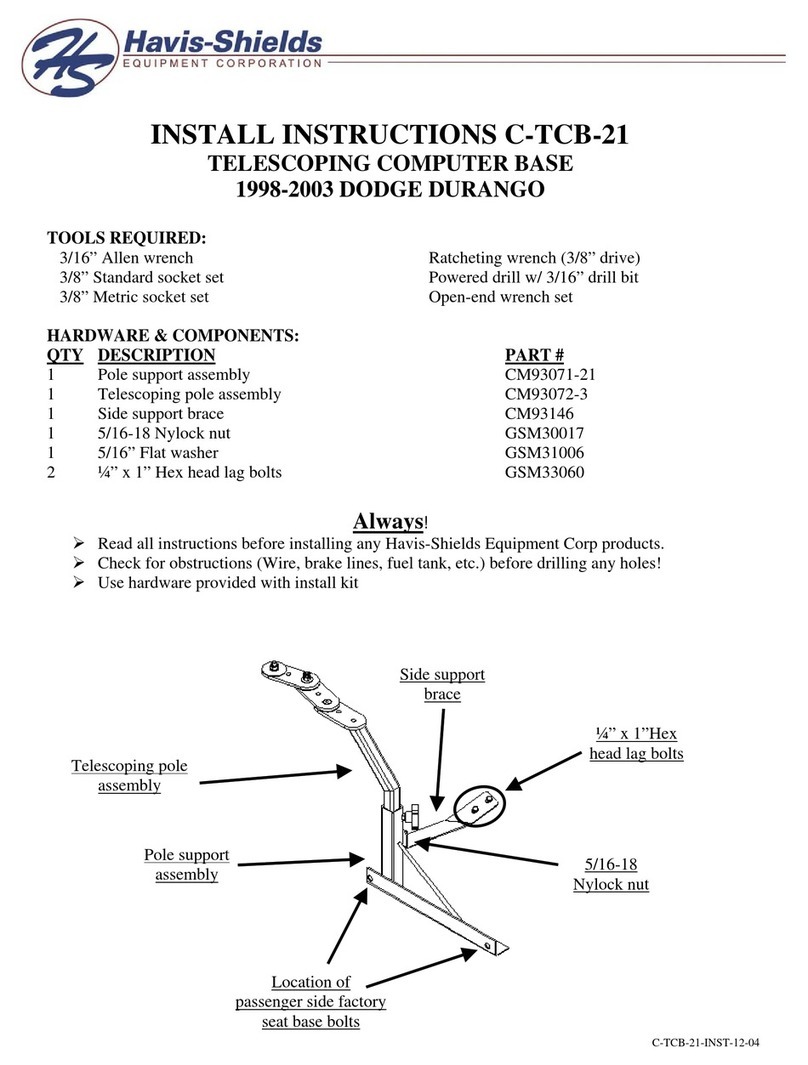
Havis-Shields
Havis-Shields Telescoping Computer Base C-TCB-21 Install instructions
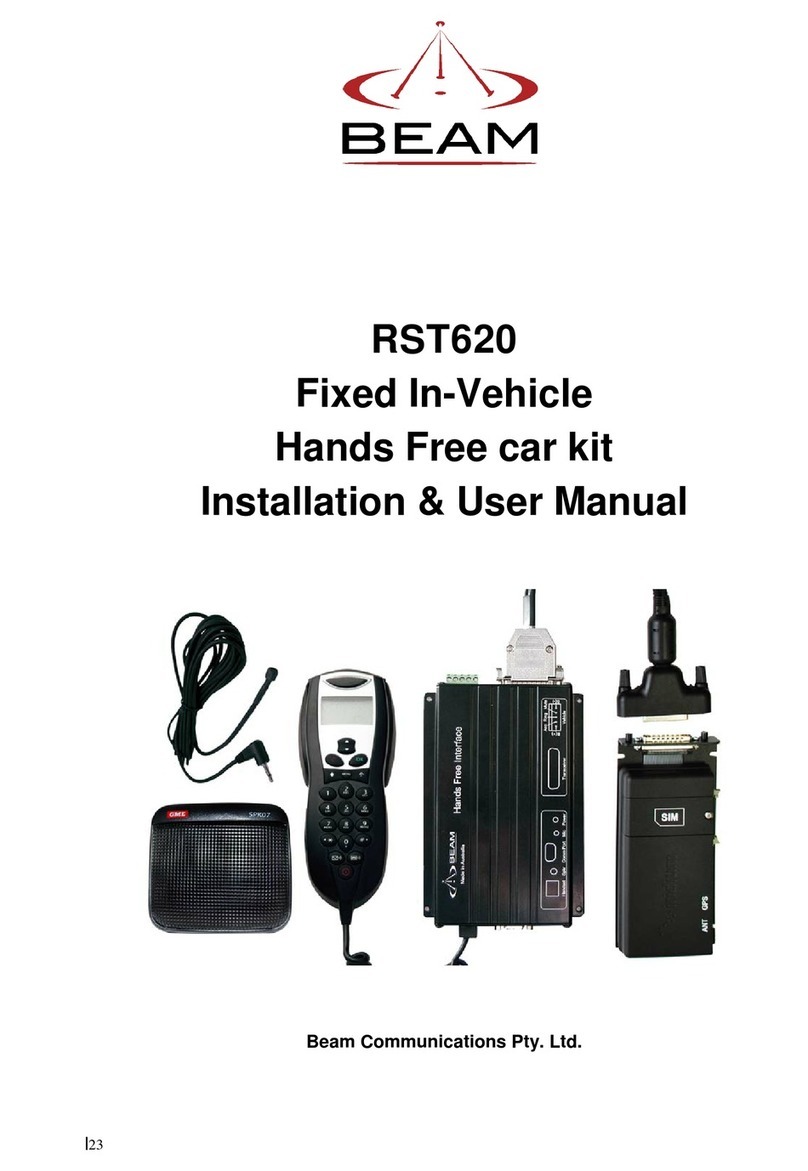
Beam
Beam RST620 Installation & user manual

STO N SHO
STO N SHO SNS 278 manual
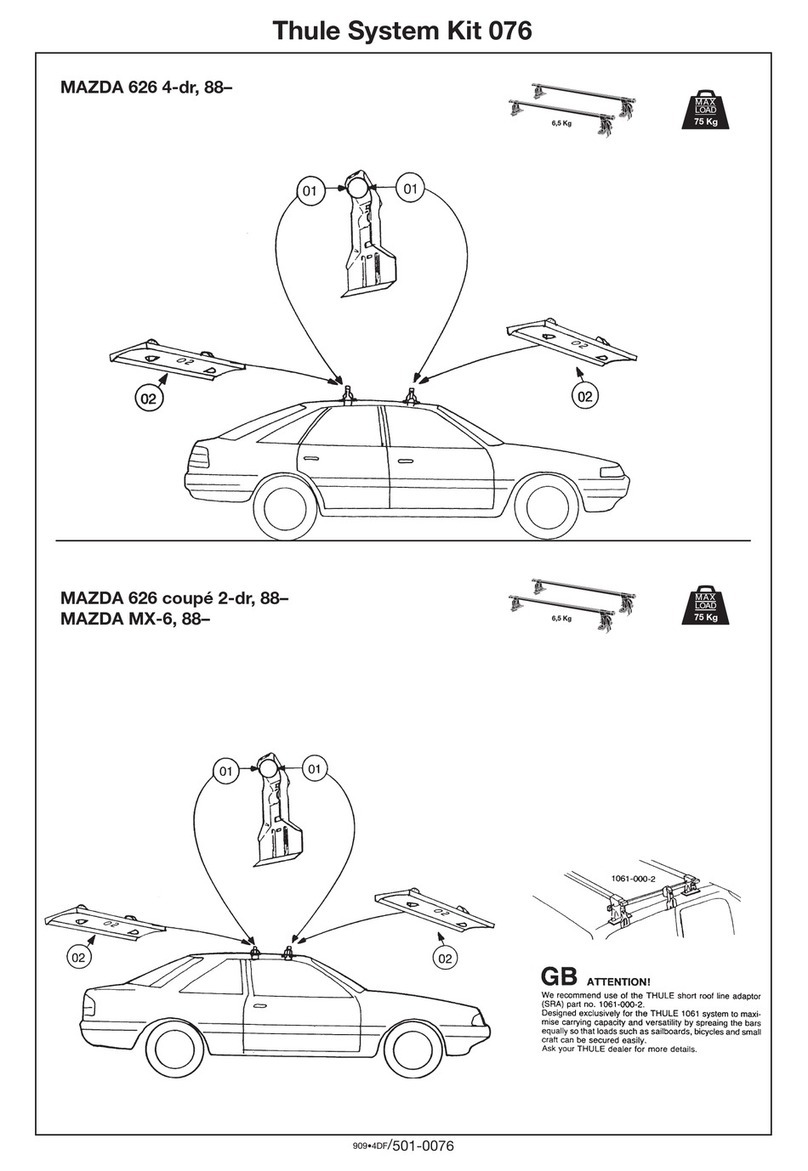
Thule
Thule 76 Mounting & installation
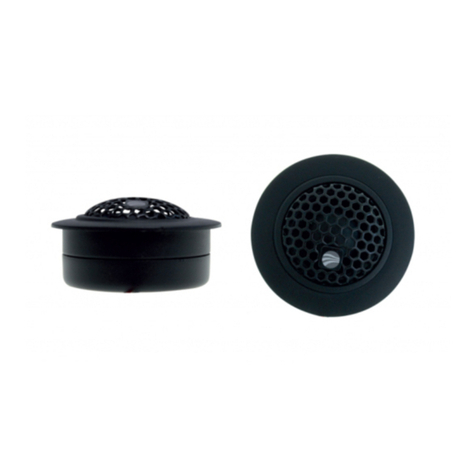
Rainbow
Rainbow Experience Series installation manual
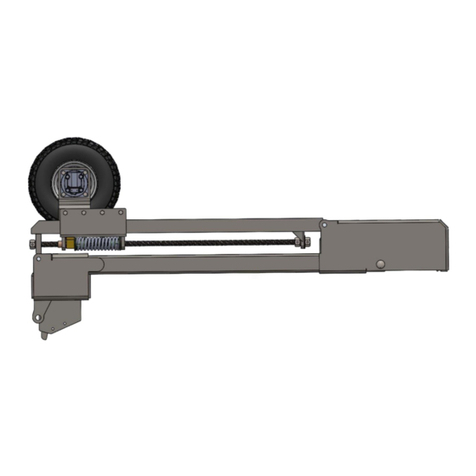
HydraBed
HydraBed Reel Lift Retrieval System installation guide
